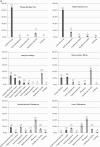Utilization of Healthcare in the Typhoid Fever Surveillance in Africa Program
- PMID: 26933023
- PMCID: PMC4772834
- DOI: 10.1093/cid/civ891
Utilization of Healthcare in the Typhoid Fever Surveillance in Africa Program
Abstract
Background: Assessing healthcare utilization is important to identify weaknesses of healthcare systems, to outline action points for preventive measures and interventions, and to more accurately estimate the disease burden in a population.
Methods: A healthcare utilization survey was developed for the Typhoid Fever Surveillance in Africa Program (TSAP) to adjust incidences of salmonellosis determined through passive, healthcare facility-based surveillance. This cross-sectional survey was conducted at 11 sites in 9 sub-Saharan African countries. Demographic data and healthcare-seeking behavior were assessed at selected households. Overall and age-stratified percentages of each study population that sought healthcare at a TSAP healthcare facility and elsewhere were determined.
Results: Overall, 88% (1007/1145) and 81% (1811/2238) of the population in Polesgo and Nioko 2, Burkina Faso, respectively, and 63% (1636/2590) in Butajira, Ethiopia, sought healthcare for fever at any TSAP healthcare facility. A far smaller proportion-namely, 20%-45% of the population in Bissau, Guinea-Bissau (1743/3885), Pikine, Senegal (1473/4659), Wad-Medani, Sudan (861/3169), and Pietermaritzburg, South Africa (667/2819); 18% (483/2622) and 9% (197/2293) in Imerintsiatosika and Isotry, Madagascar, respectively; and 4% (127/3089) in Moshi, Tanzania-sought healthcare at a TSAP healthcare facility. Patients with fever preferred to visit pharmacies in Imerintsiatosika and Isotry, and favored self-management of fever in Moshi. Age-dependent differences in healthcare utilization were also observed within and across sites.
Conclusions: Healthcare utilization for fever varied greatly across sites, and revealed that not all studied populations were under optimal surveillance. This demonstrates the importance of assessing healthcare utilization. Survey data were pivotal for the adjustment of the program's estimates of salmonellosis and other conditions associated with fever.
Keywords: healthcare utilization; sub-Saharan Africa; typhoid fever.
© The Author 2016. Published by Oxford University Press for the Infectious Diseases Society of America. All rights reserved. For permissions, e-mail journals.permissions@oup.com.
Figures


References
-
- United Nations. Millennium Development Goals and beyond 2015. Available at: http://www.un.org/millenniumgoals/. Accessed 10 August 2015.
-
- World Health Organization. Global health observatory data repository 2015. Available at: http://apps.who.int/gho/data/node.resources. Accessed 20 August 2015.
-
- United Nations Development Program. Human development reports. Available at: http://hdr.undp.org/en/content/human-development-index-hdi. Accessed 20 August 2015.
-
- World Bank Group. The World Bank 2015. Available at: http://www.worldbank.org/. Accessed 20 August 2015.
-
- Bigogo G, Audi A, Aura B, Aol G, Breiman RF, Feikin DR. Health-seeking patterns among participants of population-based morbidity surveillance in rural western Kenya: implications for calculating disease rates. Int J Infect Dis 2010; 14:e967–73. - PubMed
Publication types
MeSH terms
Grants and funding
LinkOut - more resources
Full Text Sources
Other Literature Sources

